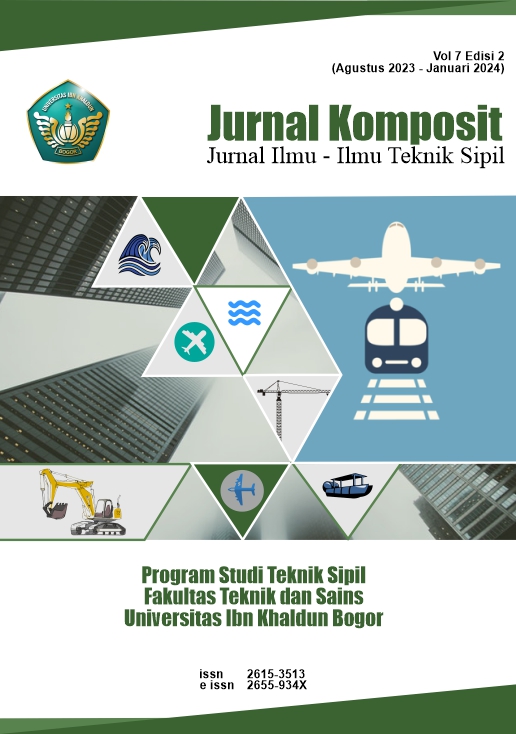AC-WC Strength Analysis with the Marshall Method on Fly Ash Mixture as a Substitute for Stone Ash Materials
DOI:
https://doi.org/10.32832/komposit.v7i2.9190Keywords:
Coal Fly ash, Marshall Test, AC-WC, Optimum Asphalt Content (OAC), MQ-optimumAbstract
Abstract: The layers contained in flexible pavement, one of which is the Asphalt Concrete-Wearing Course (AC-WC) layer, is a layer that is quickly damaged compared to other layers, because this layer is located at the top and is directly related to environmental conditions and vehicle wheel loads. One of the efforts that can be made to increase the strength of the road pavement structure in the AC-WC layer is by utilizing waste material from burning coal as a substitute for stone ash. The material used is fly ash mixed with successive levels namely (0: 100), (25:75), (50:50), (75:25) and (100:0). The optimum asphalt content (OAC) used was 5.78%. Based on the results of the physical characteristic test using the Marshall test, the fly ash material to be used meets the required specifications. As it is affected by aggregate gradation, bitumen content and compaction process, the flow rate increases simultaneously. The stability value obtained from the asphalt content of 5.781% (10%) variant is 1097.0 kg, higher than the other variants. Only 2 sample variants meet VIM specifications. Obtained optimum asphalt value of 5.75% which is close to the initial optimal asphalt estimated.
Key words: Coal Fly ash, Marshall Test, AC-WC, Optimum Asphalt Content, MQ-optimum
References
ACI Committee 232. (2010). The use of fly ash in concrete. Concrete (London), 44(5), 60–61.
Adi, A. S. (2017). Penggunaan Abu Batubara Hasil Pembakaran Asphalt Mixing Plant (AMP) sebagai Bahan Campuran Lapis Aspal Beton (Laston). Jurnal Teknologi Mineral dan Batubara, 13(1), 31–44. https://doi.org/10.30556/jtmb.vol13.no1.2017.144
Akbar, M. (2019). Durabilitas Lapisan Asphalt Concrete-Wearing Course (AC-WC) dengan Menggunakan Abu Terbang sebagai Bahan Pengisi di Lingkungan Air Gambut. Universitas Riau, 6(2), 1–13. (PDF-Indonesian)
Alamsyah, S. L. B., & Alifuddin, A. (2020). Konsep Design Mix Formula (DMF) Lapis Tipis Beton Aspal (LTBA) Mengacu Spesifikasi Umum 2018 Bina Marga terhadap Sifat - Sifat (ITS) dan Deformasi Bagaimana karakteristik Campuran Beraspal. Jurnal Teknik Sipil - Macca, 5(2), 141–152. (PDF-Indonesian)
Badan Standardisasi Nasional (1991) SNI 06-2489. Metode Pengujian Campuran Aspal dengan Alat Marshall. (PDF-Indonesian)
Buanti, D. H. (2018). Analisis Pengaruh Penggunaan Fly ash dan Asbuton sebagai Filler pada Asphalt Concrete-Wearing Course (AC-WC). Doctoral Dissertation, Universitas Mataram. (Indonesian)
Direktorat Jenderal Bina Marga. (2020). Spesifikasi Umum Bina Marga 2018 Untuk Pekerjaan Konstruksi Jalan dan Jembatan (Revisi 2). Kementerian Pekerjaan Umum Dan Perumahan Rakyat, 1036. (PDF-Indonesian)
Fahmi, A. K. A., Qomariah, Q., & Yunaefi, Y. (2021). Karakteristik Campuran Beton Aspal (AC-WC) Dengan Menggunakan Variasi Kadar Filler Limbah Abu Terbang Batubara. Jurnal JOS-MRK, 2(1), 51–57. (PDF-Indonesian) https://doi.org/10.55404/jos-mrk.2021.02.01.51-57
Hasmiati, L. O. M. N. A. (2014). Mix Design Asphalt Concrete Wearing Course (AC-WC) dengan Menggunakan Fly ash Batu Bara Sebagai Pengganti Filler. Jurnal Stabilita, 2(1), 133–144. (PDF-Indonesian)
Insan, M. K., Hariati, F., & Taqwa, F. M. L. (2020). Studi Pemanfaatan Fly Ash dan Bottom Ash sebagai Material Stabilisasi Tanah Dasar (Studi Kasus: Pekerjaan Subgrade untuk Jalan Lingkungan di PLTU Sulawesi Utara II, Kabupaten Minahasa Selatan, Sulawesi Utara). Jurnal Komposit: Jurnal Ilmu-ilmu Teknik Sipil, 3(2), 39-44. (PDF-Indonesian) https://doi.org/10.32832/komposit.v3i2.3257
Pradani, N., Sadli, M., & Fithriayuni, D. (2016). Analisis Perancangan Tebal Perkerasan Lentur Menggunakan Metode Pd T-01-2002-B, Metode Manual Desain Perkerasan (MDP) dan Metode Nottingham pada Ruas Jalan I Gusti Ngurah Rai Palu. Forum Profesional Teknik Sipil, 4(2), 140–155. (PDF-Indonesian)
Rachman, F., Syammaun, T., & Heikal, F. (2021). Pengaruh Limbah Batu Bara sebagai Filler terhadap Karakteristik Marshall dan Indek Kekuatan Sisa pada Campuran Aspal Beton AC-WC. Tameh: Journal of Civil Engineering, 8(1), 23–33. (PDF-Indonesian) https://doi.org/10.37598/tameh.v8i1.64
Sadillah, M., Arifin, M. Z., & Wicaksono, A. (2018). Sebagai Filler Terhadap Karateristik Marshall Beton Aspal Lapis Aus (AC-WC). Jurnal Rekayasa Sipil & Lingkungan, 2(1), 87–98. (PDF-Indonesian)
Susanto, H. A. (2020). Perbandingan Karakteristik Pengujian Marshall Campuran Aspal Beton dengan Filler Pasir Besi dan Abu Batu. Potensi : Jurnal Sipil Politeknik, 22(1), 13–20. (PDF-Indonesian) https://doi.org/10.35313/potensi.v22i1.1807
Umboh, A. H., Sumajouw, M. D., & Windah, R. S. (2014). Pengaruh Pemanfaatan Abu Terbang (Fly Ash) dari PLTU II Sulawesi Utara sebagai Substitusi Parsial Semen Terhadap Kuat Tekan Beton. Jurnal Sipil Statik, 2(7). (PDF-Indonesian)
Downloads
Published
How to Cite
Issue
Section
License
Copyright (c) 2023 Jurnal Komposit: Jurnal Ilmu-ilmu Teknik Sipil

This work is licensed under a Creative Commons Attribution-ShareAlike 4.0 International License.
Authors who publish with this journal agree to the following terms (Penulis yang mengajukan publikasi artikel telah menyetujui hal berikut):
- Through this publication, the author agree to submit the copyright of article writing to Jurnal Komposit: Jurnal Ilmu-ilmu Teknik Sipil. This copyright submission takes the form of, but is not limited to: reproduction of the article and parts therein, including photographic reproductions; distribution of articles through printed and electronic documents; and translation of articles(Bahwa melalui publikasi ini, hak cipta penulisan artikel diserahkan kepada Jurnal Komposit: Jurnal Ilmu-ilmu Teknik Sipil. Penyerahan hak cipta ini berupa, namun tidak terbatas pada: perbanyakan artikel dan bagian di dalamnya, termasuk reproduksi fotografi; penyebarluasan artikel melalui dokumen cetak dan elektronik; serta penterjemahan artikel).
- The authors agree to the terms of the Copyright Notice, according to Creative Commons Attribution-NonCommercial-ShareAlike 4.0 International License., which will apply to this article if and when it is published by Jurnal Komposit: Jurnal Ilmu-ilmu Teknik Sipil. (Para penulis setuju dengan ketentuan Pemberitahuan Hak Cipta, sesuai dengan Lisensi Internasional Creative Commons Attribution-NonCommercial-ShareAlike 4.0., yang akan berlaku untuk artikel ini jika dan ketika diterbitkan oleh Jurnal Komposit: Jurnal Ilmu-ilmu Teknik Sipil).

This work is licensed under a Creative Commons Attribution-NonCommercial-ShareAlike 4.0 International License.



.png)










